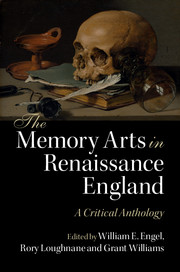Book contents
- Frontmatter
- Dedication
- Contents
- List of figures
- Acknowledgements
- A note on abbreviations
- Introduction
- PART I The art of memory
- PART II Rhetoric and poetics
- PART III Education and science
- Introduction to Part III
- III.1 Thomas Elyot, The Governor (1531)
- III.2 Roger Ascham, The Schoolmaster (1570)
- III.3 Levinus Lemnius, The Touchstone of Complexions (1576)
- III.4 William Kempe, The Education of Children (1588)
- III.5 John Brinsley, Ludus literarius (1612)
- III.6 Robert Burton, The Anatomy of Melancholy (1621)
- III.7 Thomas Sprat, The History of the Royal Society (1667)
- III.8 John Wilkins, An Essay towards a Real Character (1668)
- III.9 Obadiah Walker, Of Education (1673)
- III.10 Robert Hooke, ‘An Hypothetical Explication of Memory’ (1682)
- PART IV History and philosophy
- PART V Religion and devotion
- PART VI Literature
- Index
Introduction to Part III
from PART III - Education and science
Published online by Cambridge University Press: 05 August 2016
- Frontmatter
- Dedication
- Contents
- List of figures
- Acknowledgements
- A note on abbreviations
- Introduction
- PART I The art of memory
- PART II Rhetoric and poetics
- PART III Education and science
- Introduction to Part III
- III.1 Thomas Elyot, The Governor (1531)
- III.2 Roger Ascham, The Schoolmaster (1570)
- III.3 Levinus Lemnius, The Touchstone of Complexions (1576)
- III.4 William Kempe, The Education of Children (1588)
- III.5 John Brinsley, Ludus literarius (1612)
- III.6 Robert Burton, The Anatomy of Melancholy (1621)
- III.7 Thomas Sprat, The History of the Royal Society (1667)
- III.8 John Wilkins, An Essay towards a Real Character (1668)
- III.9 Obadiah Walker, Of Education (1673)
- III.10 Robert Hooke, ‘An Hypothetical Explication of Memory’ (1682)
- PART IV History and philosophy
- PART V Religion and devotion
- PART VI Literature
- Index
Summary
The word ‘science’ in the Renaissance implied the acquisition of knowledge. Early on it referred to the particular knowledge gained from books (especially Hebrew, Greek or Latin, as well as glosses and commentaries); and later indicated what could be learned from experience and observation. The latter is signalled in the title of Bacon's Novum organum scientiarum, which seeks to renovate human learning through a method surpassing the syllogisms associated with Aristotle's body of work, a method deployed in his Advancement of Learning (IV.3).
Education, as its etymology implies, leads one out of ignorance. By the mid fifteenth century it meant the bringing up and proper instruction of children, consistent with the scriptural verse: ‘Train up a child in the way he should go: and when he is old, he will not depart from it’ (Prov. 22:6). How to go about this, with an eye towards moral development and practical applications of lessons, differed depending on status, gender and class. The entries presented here clarify some of the main pedagogical tendencies, including Plato's notion of anamnesis (that knowledge is based on memory), often mentioned in treatises on education.
John Comenius pioneered the first sustained use of pictures to stimulate and aid the memory in a textbook covering the rudiments of reading and disputation as well as moral philosophy and natural science. His Orbis sensualium pictus [Visible World in Pictures] (1658) was translated into English by Robert Hoole, a schoolmaster whose own previous publications included a children's version of Aesop's fables.
As this Comenian lesson in orthography clarifies (Figure III.1), children will learn how ‘to speak out rightly’ by imitating the sounds of the alphabet playfully rendered as utterances associated with animals – and the familiar call of a carter to his horse (‘o o o’). The deliberate use of Latin onomatopoeic verbs and teaching vocabulary through echoic patterns result in the description of the crow's call as ‘cornix cornicatur’ and the cuckoo's song as ‘cuculus cuculat’. The images before one's eyes, coupled with the graphic renderings of the animals’ calls, made the lessons easy to remember; moreover, because they are displayed schematically and alphabetically, pupils can attend to the ‘plain sounds’ that ‘living creatures know how to make, and thy tongue knoweth how to imitate’, and then ‘go into the World, and we will view all things’.
- Type
- Chapter
- Information
- The Memory Arts in Renaissance EnglandA Critical Anthology, pp. 143 - 148Publisher: Cambridge University PressPrint publication year: 2016



